
by Ray Bodrey | Aug 19, 2016
Being a gardener in the panhandle has its advantages. We’re able to grow a tremendous variety of vegetables on a year-round basis. However, in this climate, plant diseases, insects and weeds can often thrive. Usually, chemical measures are applied to thwart these pests. Some panhandle gardeners are now searching for techniques regarding a more natural form of gardening, known as organic. With fall garden planting just ahead, this may be an option for conventional vegetable gardeners looking for a challenge.
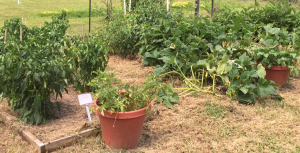
Vegetable Garden at UF/IFAS Extension Wakulla County. Photo credit: Ray Bodrey UF/IFAS.
So, what is organic gardening? Well, that really depends on who you ask. A broad definition is gardening without the use of synthesized fertilizers and industrial pesticides. Fair warning, “organic” does not translate into easier physical gardening methods. Laborious weeding and amending of soil are big parts of this gardening philosophy. This begs the question, why give up these proven industrial nutrient and pest control practices? Answer: organic gardening enthusiasts are extremely health conscious with the belief that vigorous outdoor activity coupled with food free of industrial chemicals will lead to better nutrition and health.
As stated earlier, the main difference between conventional and organic gardening is the methods used in fertilization and pest control. In either gardening style, be sure to select a garden plot with well-drained soil, as this is key for any vegetable crop. Soil preparation is the most important step in the process. To have a successful organic operation, the garden will require abundant quantities of organic material, usually in the form of animal manures and compost or mixed organic fertilizer. These materials will ensure water and nutrient holding capacity. Organic matter also supports microbiological activity in the soil. This contributes additional nutrients for plant uptake. Organic fertilizers and conditioners work very slowly. The vegetable garden soil will need to be mixed and prepped at least three weeks ahead of planting.
Effective organic pest management begins with observing the correct planting times, selection of the proper plant variety and water scheduling. Selecting vegetable varieties with pest resistant characteristics should be considered. Crop rotation is also a must. Members of the same crop family should not be planted repeatedly in the same organic garden soil. Over watering can be an issue. Avoid soils from becoming too wet and water only during daylight hours.
For weed management, using hand tools to physically removing weeds is the only control method. As for insect management, planting native plants in the immediate landscape of the organic garden will help draw in beneficial insects that will feast on garden insect pests. The use of horticultural oil or neem oil is useful. However, please read the product label. Some brands of oils are not necessarily “organic”. Nematodes, which are microscopic worms that attack plant roots, are less likely an issue in organic gardens. High levels of organic matter in soil causes an inhospitable environment for nematodes. Organic disease management unfortunately offers little to no controls. Sanitation, planting resistant varieties and crop rotation are the only defense mechanisms. Sanitation refers to avoiding the introduction of potential diseased transplants. Disinfecting gardens tools will also help. Hydrogen peroxide, chlorine and household bleach are disinfecting chemicals allowed in organic gardening settings as these chemicals are used in organic production systems for sanitation. Staking and mulching are also ways to keep plants from diseases by avoiding contact with each other and the soil.
Organic gardening can be a challenge to manage, but better health and nutrition could be the reward. Please take the article recommendations into consideration when deciding on whether to plant an organic garden. For more information, contact your local county extension office.
Supporting information for this article can be found in the UF/IFAS EDIS publication, Organic Vegetable Gardening in Florida, by Danielle D. Treadwell, Sydney Park Brown, James Stephens, and Susan Webb.

by Sheila Dunning | Aug 19, 2016
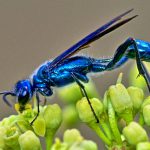 With all the media discussion of “bad” insects, like mosquitoes, many of the good guys are forgotten. One that has been very active this summer is the blue mud dauber, Chalybion californicum. These wasps are metallic blue, blue-green or blackish in color with very short narrow waists. During the summer, female blue mud daubers build nests by bringing water to abandoned mud nests made by other species of mud dauber wasps. They form new mud chambers, stock them with paralyzed spiders and a single egg, then seal the chambers with more mud. Their offspring stay in the chamber, feeding on the spiders, and then pupate in a thin silk cocoon. They spend the winter in the nest, emerging the following spring as adults.
With all the media discussion of “bad” insects, like mosquitoes, many of the good guys are forgotten. One that has been very active this summer is the blue mud dauber, Chalybion californicum. These wasps are metallic blue, blue-green or blackish in color with very short narrow waists. During the summer, female blue mud daubers build nests by bringing water to abandoned mud nests made by other species of mud dauber wasps. They form new mud chambers, stock them with paralyzed spiders and a single egg, then seal the chambers with more mud. Their offspring stay in the chamber, feeding on the spiders, and then pupate in a thin silk cocoon. They spend the winter in the nest, emerging the following spring as adults.
Blue mud daubers are solitary wasps and not known to be aggressive. When the females have carried water to an old black and yellow mud dauber’s nest, she softens it and remolds it to her needs. The result is a very lumpy version of the originally smooth nest. Next she must fill the nest with food for her future offspring. The blue mud dauber prays on spiders.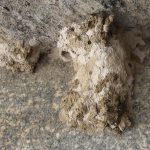
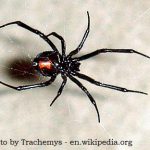 If orb weavers, lynx or crab spiders are plentiful, the blue mud dauber is able to land on their web without getting entangled and pluck the web to simulate an insect in distress. When the spider rushes to capture its prey, the poor arachnid becomes the victim of the wasp’s paralyzing sting and is quickly flown to the mud nest. However, the preferred host of the blue mud dauber is the southern black widow. Even without the elaborate web game, this wasp can control a dangerous nuisance. Once at the nest with her spider victim, the blue mud dauber stores the paralyzed arachnid at the bottom of a mud cell and lays a single egg onto its body. When the wasp larva hatches it consumes the remaining body of the spider. With a full belly, the mature larva spins a papery silken cocoon within the mud nest and begins to pupate. The following spring an adult wasp chews a round hole in the end of the mud cell and exits it’s winter home.
If orb weavers, lynx or crab spiders are plentiful, the blue mud dauber is able to land on their web without getting entangled and pluck the web to simulate an insect in distress. When the spider rushes to capture its prey, the poor arachnid becomes the victim of the wasp’s paralyzing sting and is quickly flown to the mud nest. However, the preferred host of the blue mud dauber is the southern black widow. Even without the elaborate web game, this wasp can control a dangerous nuisance. Once at the nest with her spider victim, the blue mud dauber stores the paralyzed arachnid at the bottom of a mud cell and lays a single egg onto its body. When the wasp larva hatches it consumes the remaining body of the spider. With a full belly, the mature larva spins a papery silken cocoon within the mud nest and begins to pupate. The following spring an adult wasp chews a round hole in the end of the mud cell and exits it’s winter home.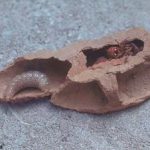
As adults, the blue mud dauber feeds on nectar from flowers and honeydew secreted by insects. Should you encounter a large congregation of this normally solitary wasp, don’t be alarmed. It is probably just a bunch of male blue mud daubers gathering together to sleep it off, after a heavy day of “drinking.”
So, rather than having to cover yourself in DEET just to spend the evening on the patio, brave the heat (with water bottle in hand, of course) and spend the daytime hours watching the blue mud daubers prepare their nest for next year’s young. Maybe the media will pick up on wasp that are reducing black widow populations, rather than the dangers of mosquitoes.
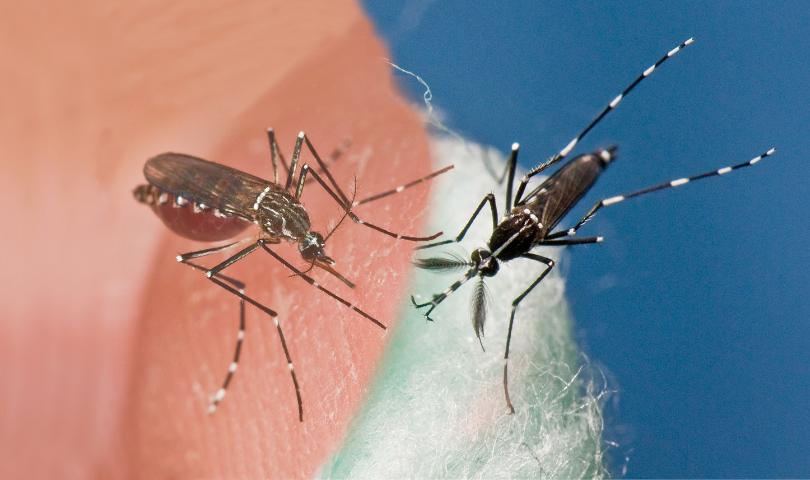
by Mary Salinas | Jul 7, 2016
The Zika virus has made us all more aware of the need to avoid getting bit by mosquitoes when we travel to those destinations that have confirmed reports of Zika infected mosquitoes. The Centers for Disease Control and Prevention lists the countries and territories that have travel notices to consult prior to planning a trip or traveling.

The invasive mosquitoes Aedes aegypti (left) and Aedes albopictus (right) occur in the Americas, including Florida, and have been implicated in the transmission of Zika virus.
Credit: J Newman, UF/IFAS/FMEL
The Florida Department of Health has recommendations for preventative action to take when traveling to any location that has confirmed Zika virus.
- You should use an insect repellant (following all label instructions) with any of these active ingredients:
- DEET
- Picaridin
- Oil of lemon eucalyptus
- Para-menthane diol
- IR3535
- Wear long-sleeved shirts and pants
- Wear clothing that is pre-treated with permethrin or apply a permethrin product to your clothes, but not your skin!
- Avoid getting bitten while you sleep by choosing a place with air conditioning or screens on windows and doors or sleep under a mosquito bed net.
According to the Georgia Department of Public Health you should also protect yourself against mosquito bites for at least a week after you return home from any location that has confirmed Zika. You may have an active infection without symptoms that can be spread to others through mosquito bites.
Now let’s talk about mosquito control in your own landscape.
Even though we don’t have confirmed Zika infection in Florida mosquitoes at this writing, mosquitoes in our state can transmit other diseases such as: eastern equine encephalitis, dengue fever, dog or cat heartworm, chikungunya, malaria, St. Louis encephalitis and west Nile virus.
Let’s first explore what kind of environment in your landscape and around your home is friendly to the proliferation of mosquitoes. Adult mosquitoes lay their eggs on or very near water that is still or stagnant. That is because the larvae live in the water but have to come to the surface regularly to breeze. The small delicate larvae need the water surface to be still in order to surface and breathe. Water that is continually moving or flowing inhibits mosquito populations.
Look around your home and landscape for these possible sites of still water that can be excellent mosquito breeding grounds:
- bird baths
- potted plant saucers
- pet dishes
- old tires
- ponds
- roof gutters
- tarps over boats or recreational vehicles
- rain barrels (screen mesh over the opening will prevent females from laying their eggs)
- bromeliads (they hold water in their central cup or leaf axils)
- any other structure that will hold even a small amount of water (I even had them on a heating mat in a greenhouse that had very shallow puddles of water!)
You may want to rid yourself of some of these sources of standing water or empty them every three to four days. What if you have bromeliads, a pond or some other standing water and you want to keep them and yet control mosquitoes? There is an environmentally responsible solution. Some bacteria, Bacillus thuringiensis ssp. israelensis or Bacillus sphaericus, only infects mosquitoes and other close relatives like gnats and blackflies and is harmless to all other organisms. Look for products on the market that contain this bacteria.
For more information:
Zika, a Mosquito-Transmitted Virus
Mosquito Repellents
UF/IFAS Mosquito Information Website
Florida Container Mosquitoes
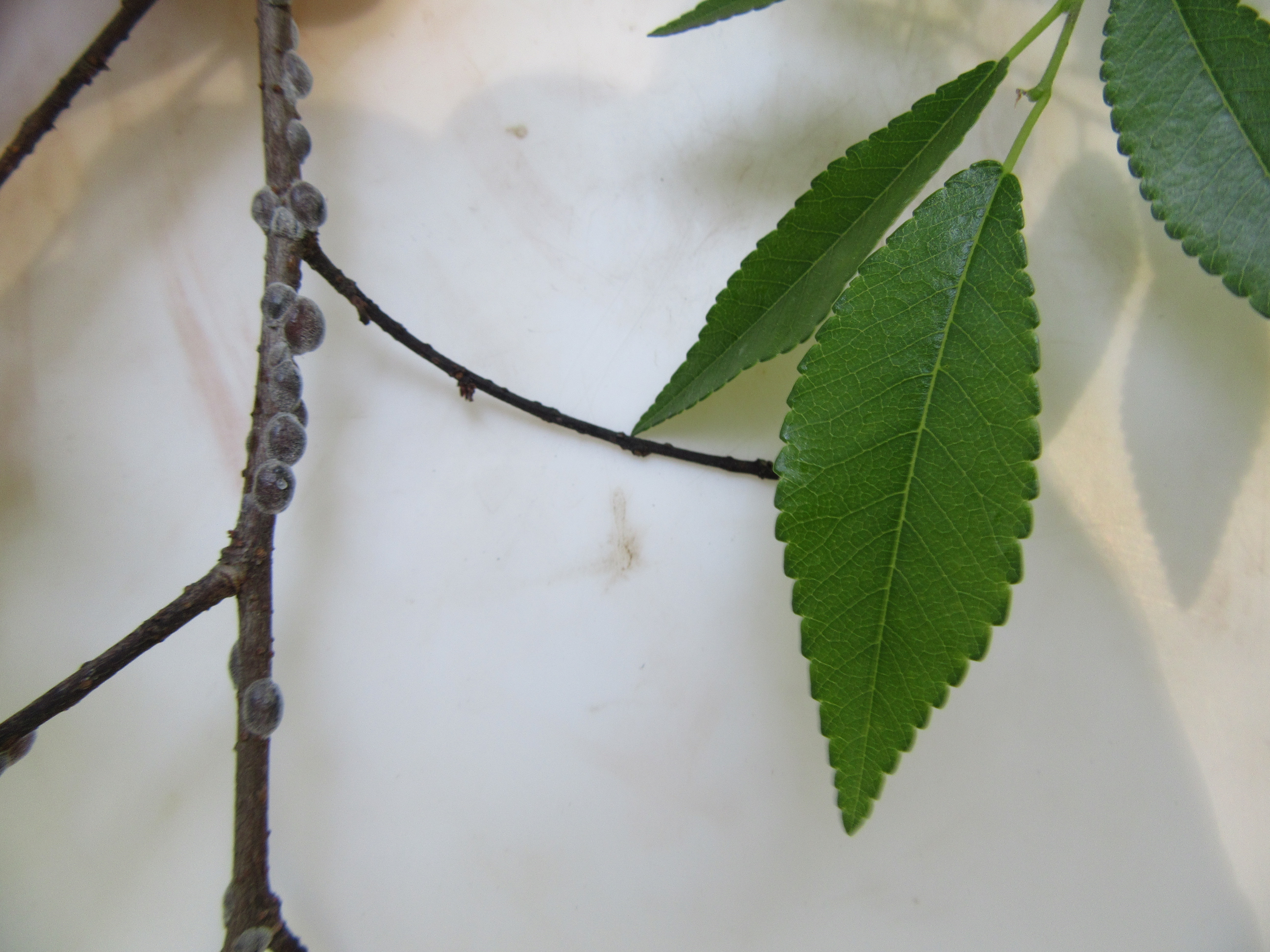
by Matt Lollar | Apr 14, 2016
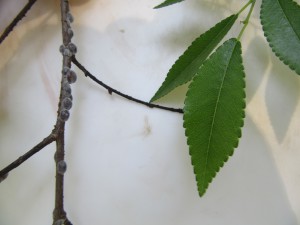
Scales on a Chinese Elm.

Scales on a Chinese Elm.
Last week as I was basking in the shade of the Chinese Elms (Ulmus parvifolia) in my yard, I noticed some strange lumps on the twigs. Upon further investigation, I realized the “lumps” were scales. Scale insects are serious pests of a number of ornamental plants. Here in Florida there are 13 different families of scales with the most common being armored scales, soft scales, and mealybugs. Scales have piercing-sucking mouthparts which they use to siphon fluids from the leaves, stems, and sometimes roots of many ornamental plants. Heavy infestations cause extensive leaf yellowing, premature leaf drop, branch dieback, and eventually plant death.
Scale Biology
The life cycle of a scale begins with eggs being laid beneath wax coverings or beneath the adult female. Eggs typically hatch in 1 to 3 weeks. The newly hatched nymphs, called crawlers, move around a plant until they find a spot to feed. Once a feeding site is located, their piercing sucking mouthparts are inserted into the plant and the crawlers begin to feed and grow. The males of many scale species develop wings as adults and fly to other plants to reproduce.
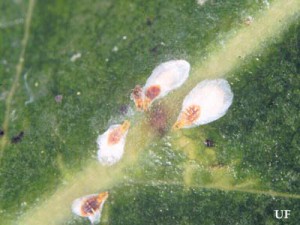
The magnolia white scale. Credits: University of Florida
Armored Scales
Armored scales get their armor by secreting a waxy covering over their bodies that is not attached. The scale lives under this covering and uses it as a protection to feed under. Armored scales can be almost any color or shape and range anywhere from 1/16 to 1/8 inch in diameter. For females, these shapes range from circular to oval to long and slender. The males typically have coverings that are more elongate and smaller than the females. As adults, the males are tiny, winged, gnat-like insects and are rarely seen.
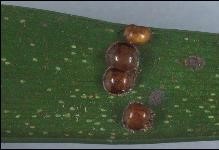
Hemispherical scale on coontie. Credits: Lyle Buss, University of Florida
Soft Scales
Similar to armored scales, soft scales secrete a waxy covering, but it is attached to their bodies. Soft scales can be a number of colors, shapes, and sizes and range anywhere from 1/8 to 1/2 inch in diameter. Their shapes vary from spherical to nearly flat.
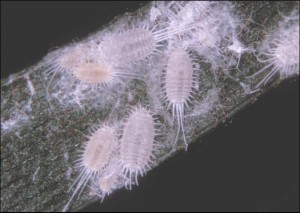
Mealybugs. Credits: James Castner, University of Florida
Mealybugs
Mealybugs are soft-bodied insects that possess a covering of flocculent, white, waxy filaments. They are about 1/8 inch in length and usually pinkish or yellowish in color. Mealybugs have piercing-sucking mouthparts which they use to siphon fluids from the leaves, stems, and sometimes roots of many ornamental plants. Mealybug damage produces discolored, wilted, and deformed leaves.
Scale and Mealybug Management
- Cultural Control – Plant inspection prior to purchase or installation is the first line of defense against a scale or mealybug population. Make sure to inspect the undersides of leaves and plant stems. Infested sections of plants can be pruned and plant material should be cleaned from the planting area and discarded. Also, you can increase air flow and decrease humidity by proper installation and pruning. Over-fertilizing can also increase pest populations.
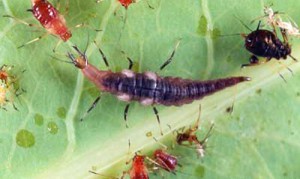
Larva of a brown lacewing. Credits: Lyle Buss, University of Florida.
- Biological Control – Predators, such as ladybugs and green lacewings, are usually present in large enough numbers to suppress scales and mealybugs to a desirable threshold. However, broad-spectrum insecticides and bad weather can reduce predator numbers. Look for signs of predation by inspecting dead scales for jagged holes in their waxy coatings. If predation signs are present, use more selective chemical controls and oils as opposed to broad-spectrum products.
- Chemical Control – Timing is everything when it comes to managing scale and mealybug insects. Crawler activity is more pronounced with the flush of new plant growth in the spring. Before application, prune infested plant parts off first to promote greater penetration of insecticides into the foliage. Contact products (acephate, bifenthrin, carbaryl, etc.) must be applied to inhibit the crawler stages of these insects and systemic products (acetamiprid, imidacloprid, thiamethoxam, etc.) can be used on the sessile growth stage. Plants should be sprayed thoroughly to the point of drip or “run off” from leaves, twigs, and stems. Repeated applications may still be necessary even if the timing is right, as crawler populations are often large and crawlers like to hide under old waxy scales. Systemic drenches are also a viable option. With good spray coverage, horticultural oils can kill scales at all stages of growth. Refer to the product label for phytotoxicity and temperature guidelines. Even after successful treatment, the outer coatings of the scales may remain on the plant material for weeks, which can be unsightly. The best way to determine if scales are dead is to squeeze them. They will be dry when squeezed if they are dead and they will ooze liquids if they are living (they were at least alive to the point of being squashed).
For insect identification and additional information on scale control, please see:
A Guide to Scale Insect Identification
UF/IFAS Featured Creatures
Your County Extension Office
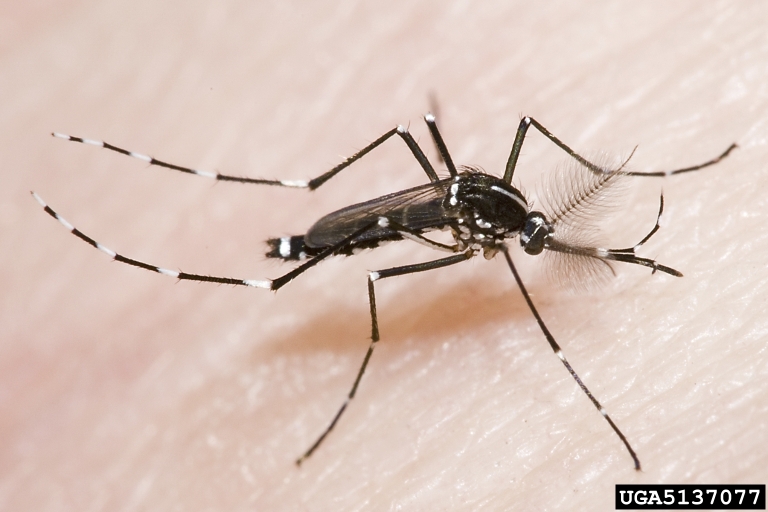
by Mary Salinas | Nov 9, 2015
Are you plagued with mosquitoes in your yard? Does it seem like you have a greater infestation than your neighbors? There may be some solutions to solve the problem other than using pesticides that negatively impact beneficial insects in your landscape.
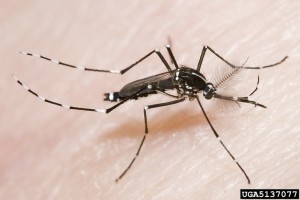
Asian tiger mosquito. Photo credit: Susan Ellis, Bugwood.org.
Mosquitoes are not only annoying, they can transmit serious diseases such as: eastern equine encephalitis, dengue fever, dog or cat heartworm, chikungunya, malaria, St. Louis encephalitis and west Nile virus.
Let’s first explore what kind of environment in your landscape and around your home is friendly to the proliferation of mosquitos. Adult mosquitoes lay their eggs on or very near water that is still or stagnant. That is because the larvae live in the water but have to come to the surface regularly to breeze. The small delicate larvae need the water surface to be still in order to surface and breathe. Water that is continually moving or flowing inhibits mosquito populations.
Look around your home and landscape for these possible sites of still water that can be excellent mosquito breeding grounds:
- bird baths
- potted plant saucers
- pet dishes
- old tires
- ponds
- roof gutters
- tarps over boats or recreational vehicles
- rain barrels (screen mesh over the opening will prevent females from laying their eggs)
- bromeliads (they hold water in their central cup or leaf axils)
- any other structure that will hold even a small amount of water (I even had them on a heating mat in a greenhouse that had very shallow puddles of water!)
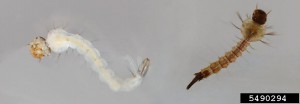
Mosquito larvae. Photo credit: Ari Farajollahi, Bugwood.org.
You may want to rid yourself of some of these sources of standing water or empty them every three to four days. What if you have bromeliads, a pond or some other standing water and you want to keep them and yet control mosquitoes? There is an environmentally responsible solution. Some bacteria, Bacillus thuringiensis ssp. israelensis or Bacillus sphaericus, only infects mosquitoes and other close relatives like gnats and blackflies and is harmless to all other organisms. Look for products on the market that contain this bacteria.
For more information:
UF/IFAS Mosquito Information Website
Biological Control of Mosquitoes



















